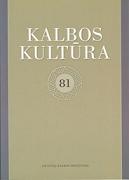Dėl kalbos kultūros mokymo
On teaching language culture
Author(s): Rita MiliūnaitėSubject(s): Language and Literature Studies
Published by: Lietuvių Kalbos Institutas
Keywords: Language culture; language errors; education; standard language; functional styles; language norms; variants
Summary/Abstract: The paper claims that teaching the culture of language has lost its primary aim—to teach accurate standard language and educate language users so that they could freely make use of means of linguistic expression to satisfy the needs of their professional and everyday life. The culture of language eventually becomes a discipline of teaching language errors, the process of teaching is overloaded with examples of norm violation, which are not always relevant. Prevailing task type involves correcting errors in the texts of other students or texts artificially produced for the purpose of teaching rather than one’s own texts. The paper discusses several textbooks for students of colleges and higher education institutions. As a result, the following conclusions are drawn: 1. Ways should be sought how to make the teaching of norms of standard Lithuanian more systemic, creative and effective: the approach based on correcting errors and then explicating norms and generally going from form to function should be replaced by the opposite with the focus on the creative aspect of language. 2. Textbooks on standard Lithuanian norms and language culture should be written with more responsibility and more accurately, viz.: – the theory should be presented in a more systemic way, avoiding contradictions; the terms standard language, functional styles, language norms etc. have to be more precise; – a clearer distinction should be made between gross violations of standard language norms and stylistic variants of less constrained language; – the selection of examples of normative and non-normative language should respond to the linguistic needs of modern society; – some tasks should have a more clearly defined aim and wording so that students understand what and how should be done, what result is expected of them. 3. The question of two-tier system of teaching standard language should be discussed. first would focus on the foundations of language norms and key violations of the norm; the second would address exemplary language responding to the needs of a profession. Thus the process of teaching would not be overloaded with facts, after the foundations are laid, different variants of the norm and more subtle language expression and style could be taught. 4. Preserving the priority of standard language, schools should get access to the understanding of other language varieties (regional and social dialects, professional language) their functions and social value.
Journal: Bendrinė kalba (iki 2014 metų – Kalbos kultūra)
- Issue Year: 2008
- Issue No: 81
- Page Range: 151-169
- Page Count: 19
- Language: Lithuanian

